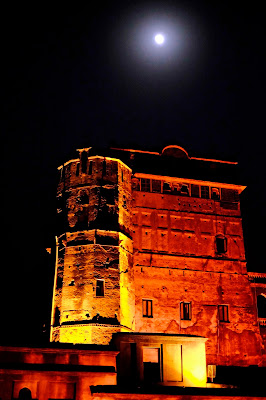 |
| Man Mandir or Man Singh Palace This is the citadel of the main fort at Gwalior. The fort changed hands and purposes through the centuries, this is reflected in the eclectic architecture and sprawl of the walls. At various times it has resonated to the sounds of battle at the fort walls; a centre for performing arts, the Gwalior gharana is one of the oldest Khyal Gharanas and flourished under the patronage of Akbar and his favorite singers including the famous Miyan Tansen ; a palace, and the agonised groans of the political prisoners of a grim prison. The sound and light show is very well done and explains the history of the fort through the ages. |
Tuesday, 6 December 2016
Central India- Tales These Stones Tell
Monday, 28 November 2016
A Hard Day's Night
Mumbai, a city that actually never sleeps. It is constantly humming with the hectic economic activity that goes on almost without let up, everyone is earning a living. Every inch of the pavement is a market, suburban trains, big shops and small shops, houses in tiny lanes, people working all day and then again all night; all this and more constitute the hive that is Mumbai. Despite the swirling activity, people are kind, considerate and allowing, they have time for you. In this maelstrom, there are tiny eddies of calm and solitude and privacy. in a three night photography workshop I gained a tiny peep into a small part of the hard lives of these lovely people.
The Beatles immortalise this in their eponymous song which says it all.
"It's been a hard day's night, and I'd been working like a dog
It's been a hard day's night, I should be sleeping like a log"
 |
| Yes Young Ladies how can I help you? These young girls find safety in numbers I guess, late night in Bandra Market street, they are the customers in a multi-specialty shop. |
 |
| Counting his money It has been a good day possibly, or is he wondering if he has enough to pay impending bills, buy more fruit for the morrow? The busy street is bustling late into the night. |
 |
| Social meet as well? It may be business, but these ladies on a late night shopping spree, gather around the fruit seller to exchange light hearted gossip. |
 |
| Solitude Notwithstanding the "standing room only" pace of the city, this couple finds an oasis of calm and privacy by the ocean wall. |
Tuesday, 18 October 2016
South Africa - Vignettes of the Cape in Spring
 |
| Mandela's Gold In a tribute to the iconic Nelson Mandela, this golden coloured Bird of Paradise is carefully bred at Kirstenbosch. The more common flower too grows in profusion here. |
 |
| The iconic Table Mountain the best place to see the breath-taking views of Cape Town is from Table Mountain. It has a cable car to go up, but for the intrepid there are many routes to climb up on foot. These are interesting trails that allow one to see the different views and flora as one climbs. There are climbs for the beginner and for the technical expert. However none of the trails are a casual walk so be prepared with adequate water (at least two litres per person on a hot day); and a jacket for the considerable change in temperature from a warm bottom (pun intended) to a windy and cold top. Please see my earlier blog on walking up Table Mountain |
Saturday, 30 July 2016
Off the beaten path at Hogenakkal Falls
 |
| Cooking al-fresco Old coracles are re-purposed by using them as roofs of huts and outdoor cooking shelters. Apart from the myriad tourist industries that such places have over here the Falls have engendered coracle boatmen, massage-men, fisher folk and fruit sellers. Here a group of men and women cook a quick lunch while others carry on with the business of the day. |
 |
| Water pots by the village tap Though a common sight, over here the traditional brass has given way to bright coloured plastic as seen by these neon coloured pots by the village tap. |
Labels:
Cauvery River,
coracle,
falls,
fish,
Hogenakkal,
waterfalls
Subscribe to:
Comments (Atom)













































